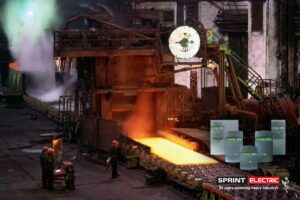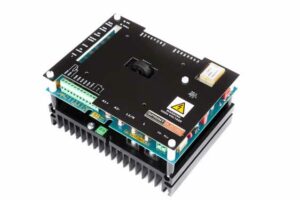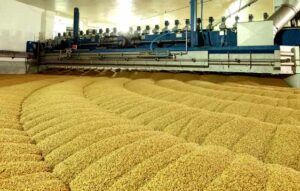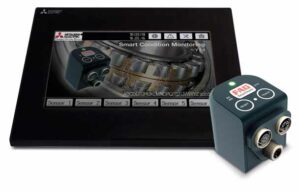Smart factories could add at least $1.5 trillion to the global economy, according to the Smart Factories Report published by Capgemini. This will only be possible if organisations can overcome the scaling challenges.
BY ANDY PYE
The automation of yesteryear is slowly becoming untenable for realising future needs, driving the evolution of control process automation from control switches and relays to advanced control systems,” says Karthik Sundaram, industrial IoT programme manager at market analyst Frost & Sullivan. “Envisioning the future of factories must first begin with a vision for the future of automation, a relatively unexplored approach.”
AI opens the door to machines that can sense, process and act in some ways like humans. It encompasses natural language processing, image/ object/sound recognition and problem- solving. Machine learning describes a system which can learn without explicit programming.
The need for ‘clean data’
The guiding star for all “industry 4.0” technologies is data, which enables companies to identify and resolve problems remotely. Eventually, machine learning might help plants automate simple engineering jobs.
“However, this future is not yet here,” says Stephen Woodhouse Chief Digital Officer at international consulting and engineering firm Pöyry. “To reach this point, we need better access to clean, accessible data streams and we need to better identify where to focus our efforts. We also need to get around practical barriers like the interoperability of these sensors. Although the limits are expanding fast, constraints on processing power, data storage and algorithms mean that the 80:20 rule still applies to data analytics. It is these practical considerations that led Pöyry to co-develop Krti 4.0, a machine learning predictive maintenance framework that works across different kinds of sensors.”
The Cloud and the Edge
Cloud data storage is often preferable to and much more sustainable than traditional on-premises storage. But it is not suitable for all forms of manufacturing data. The answer is an emerging infrastructure of so-called “edge devices”. With edge computing, computer power is sited exactly where needed – where the information is generated at the edge of the network.
This autumn, in Barcelona attending the Schneider Innovation Summit, I met Ali Haj Fraj the Senior Vice President Machine Solutions within the Business Unit Industry of Schneider Electric. He specialises in Industrial Automation and Controls and Energy Management.
“I see smart manufacturing as the collective benefit of advanced technologies to optimise operations and gain competitive advantage. Smart infrastructures within plants enable more efficient manufacturing processes, allowing for faster responses to dynamic marketplace demands,” he said.
“A truly ‘smart factory’ is one that is completely digitised with high level of automation and connectivity with its whole supply chain,” said Martin Walder, VP Industrial Automation at Schneider Electric UK. “With UK manufacturing industry under increasing pressure to deliver more, at a lower cost, the coming years will see more manufacturers take steps to create a completely ‘smart’ factory floor. Thanks to recent advancements in IoT technologies, using smart technology is feasible for a greater number of manufacturers.”
Core to the smart machine is the smart controller, one built not only to control a process but also capable of communicating and linking to an IT layer. Combined with software analytics, smart controllers enable the smart machine to react in a proactive way to changes that may happen in the future.
IT/OT convergence
Smart controllers, like the Modicon M262 shown here, are core to smart manufacturing.
OT (Operational Technology) and IT (Information Technology) teams are familiar with their own infrastructures and software. But each needs to have a fundamental understanding of the other’s respective stacks, and how changes can impact both.
“Today’s engineers have learned their trade in the last few decades, yet the skills required of them will change in the coming ones,” says Woodhouse. “In an interconnected, data-driven world, engineers will find they are required to be software and hardware engineers, and even drone operators, as much as they are required to be power engineers. Knowledge and information will be treated as a precious company resource and will be managed and maintained.”
For decades, the office environment had been on an Ethernet network, the factory floor had operated independently on Fieldbus, and each were happily separate in their operations and needed little contact with one another. Now, with the proliferation of Ethernet on the industrial side and the organization converging into a single data network spanning both, conflict seems inevitable: which department gets overall control of the Ethernet network?
The chasm between IT and OT can be large. The department traditionally responsible for data flow and that responsible for industrial controls are driven by fundamentally different incentives. For OT, availability is king, representing millions of dollars in manufacturing productivity, whereas IT tends not to mind a little downtime, as long as data security can be maintained.
There needs to be an individual capable of communicating with and relating to both departments and ensuring that they work synergistically, as well as an organization providing the proper backing and resources.
5G Technology
Unlike the massive difference that domestic consumers experience between 3G and 4G, which enabled the easy consumption of photos, video and mobile streaming, 5G is less about mobile speed than opening up new wireless applications. 5G use cases are broad in nature: IoT would support the automation of buildings, smart agriculture and smart water metering. Factory floors, now connected with wires, could be reconfigured and entirely wireless and included in real-time information flows.
“Our ambition is to not only provide industrial grade networking hardware, but also to be a strategic partner to our customers as they build secure and resilient 5G industrial networks”, says Emma Sundh, product manager at HMS Networks. The company’s Anybus Wireless Routers target industrial applications with high-speed WLAN and LTE connectivity.
Facial recognition
Facial recognition is a form of biometric identification, such as using someone’s voice, iris or fingerprint to identify them.
The more commonly used methods of tracking employees, such as key cards, are easy to bypass and do not provide the level of security required when entering classified areas.
The manufacturing industry could use facial recognition to keep track of where workers are on the factory floor, ensuring their safety in case of emergency.
Facial recognition could help to ensure that employees working at specific stations have had the necessary training to operate a piece of machinery. If the system recognises that the employee’s identity does not match the training record, the plant manager could be notified and another member of staff located to carry out the task instead.
LOOKING FORWARD
- Compared to two years ago, more organizations are progressing with smart initiatives and it is estimated that, globally, one-third of factories have already been transformed.
- Smart factories could add at least $1.5 trillion to the global economy,
- Manufacturers currently plan to create 40% more smart factories in the next five years.
- China, Germany and Japan are the top three adopting countries, followed by South Korea, United States and France.
- The PwC study, “Digital Factories 2020: Shaping the Future of Manufacturing,” predicts that the adoption of machine learning to enable predictive maintenance is expected to increase among manufacturers by 38% because of the ability to increase profit margin by eliminating unscheduled work stoppages.
- Equipment monitoring and predictive maintenance are the most commercially implemented activities so far, due to the maturity of associated AI models. Another commercial use case currently gaining momentum is defect inspection.
FOOD FOR THOUGHT
At Maintec (30-31 October NEC), Muntons Malt, one of the UK’s largest producers of malted barley, explained why it has chosen the Smart Condition Monitoring (SCM) system from Mitsubishi Electric to protect fans and motors vital to its production process. It uses sophisticated control automation and bearing monitors to accurately predict maintenance requirements.
The principles of barley malting are quite traditional, but Muntons relies heavily on automation, electro-mechanical equipment and sensors to provide fine control over air flow, heat and moisture. Fans and motors are critical to the operation: the Muntons processes many tonnes of product at a time, with key operations relying on a steady supply of blown air.
The chosen SCM installation provides condition monitoring for two large 315kW fan sets and a single 90kW fan set. Sensors monitor the electric motor, power transmission coupling and main fan shaft bearing on each fan set. “We now have a clear picture of the health of the fan sets and advance warning of any required maintenance,” says Plant Engineer Michael Plawecki. “Remote monitoring and fast diagnosis of any issues has also made us very responsive should the limits on operating parameters that we have set be approached. As promised the system was easy to install and relatively simple to commission.”
- Fans and motors are vital within Munton Malt’s large-scale production process. It uses Mitsubishi Electric’s Smart Condition Monitoring (SCM) system to protect against unscheduled downtime.
- Mitsubishi Electric’s Smart Condition Monitoring system.
DON’T DITCH DC!

Equipment in traditional industries can be integrated into
sophisticated multi-function plants – while retaining DC drives.
One of the great advantages of the move to digital technology is that it has accelerated integration of related machines into sophisticated multi-function plants. Individual machines’ drives and controls can now be connected through various communication protocols such as Profibus, Profinet, Canbus and Ethernet. This allows them to share operational data and thus optimise overall plant performance.
“The imminent demise of DC drives has been predicted for at least 30 years,” stated Sprint Electric Marketing Manager Neill Drennan. “Yet they are still going strong and in selected applications continue to outperform their more fashionable variable speed AC counterparts. With the development of Industry 4.0, we are starting to see drives become predictive and preventative, which should in the long term makes plants more productive and efficient. Plant operators sometimes think that their existing machines cannot be integrated into wide area control systems cost-effectively, particularly if they use DC motors and drives rather than AC. But DC drives can be digital and can be integrated into digital control systems.”

Sprint Electric 3200i DC Drive, with cover.
DIGITAL TWINS BRIDGE REAL AND VIRTUAL WORLDS
An objective of artificial intelligence and machine learning is to enable the development of a digital twin of a product development or production environment. Its creation uses model-based systems engineering using the machine learning algorithms and knowledge gained as a foundation.
Konecranes, which specialises in cranes and lifting equipment, has implemented Siemens’ digital innovation platform to accelerate its product development process and connect product and performance data together. The company is using MindSphere, the open, cloud-based Internet of Things (IoT) operating system, and the digital lifecycle management software Teamcenter, to construct a digital twin and reduce the number of physical prototypes. This is one of the first implementations of IoT to develop a framework that connects and synchronises the virtual (engineering design, analysis and simulation) and physical (testing and operational reliability) worlds.
“The traditional product design process is based more on the engineer’s experience and generally shared assumptions than measured facts from existing products,” said Juha Pankakoski, Executive VP, Technology at Konecranes. “These assumptions often lead to non-optimised designs that are over engineered. With an integrated digital twin platform, we see major potential in speeding up the product development process, reducing prototypes, increasing traceability and thus improving quality and reduce development cost.”




